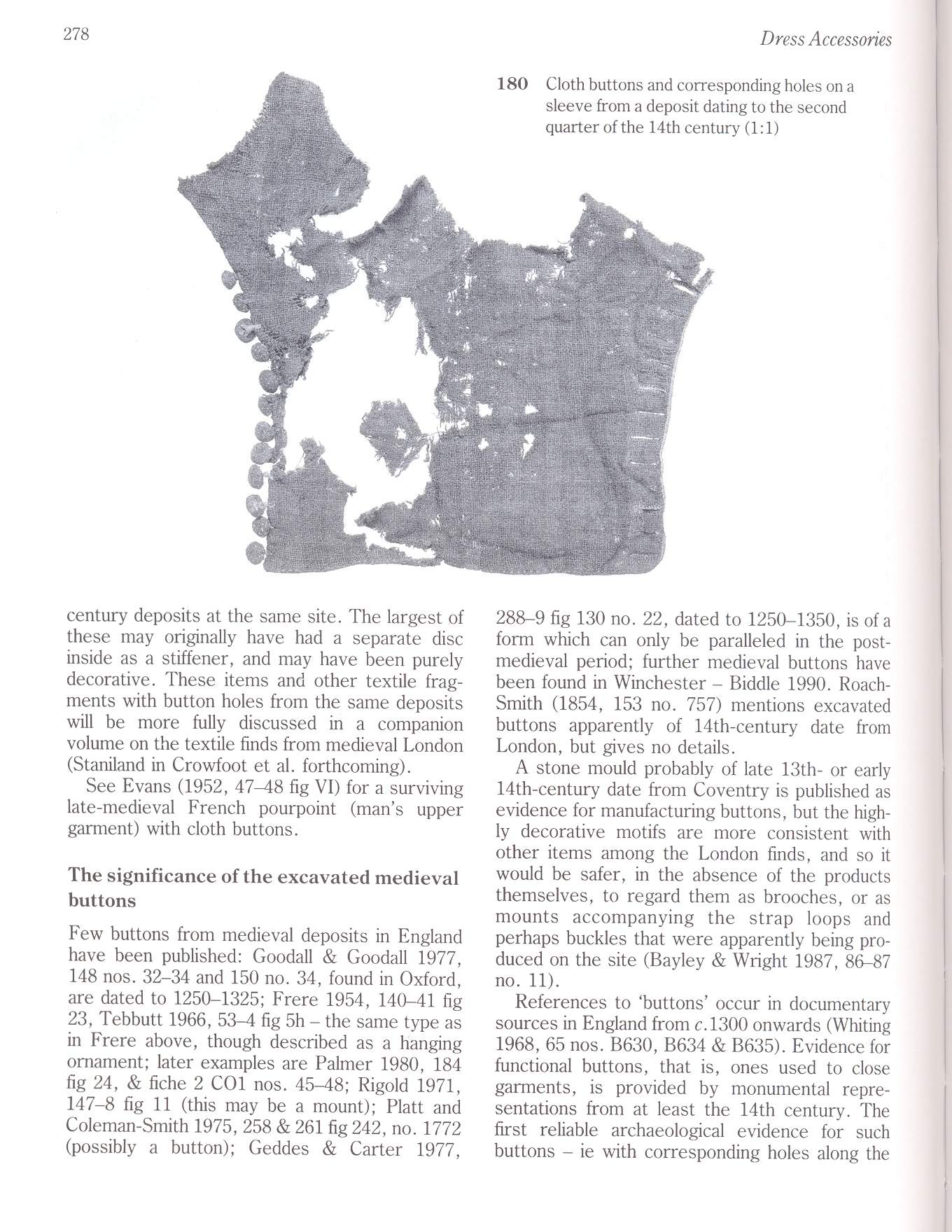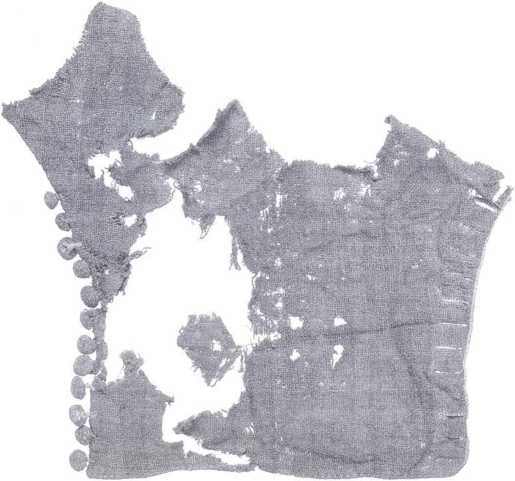306 (35)

180
180
278
Dress Accessońes

Cloth buttons and corresponding holes on a sleeve from a deposit dating to the second quarter of the 14th century (1:1)
century deposits at the same site. The largest of these may originally have had a separate disc inside as a stiffener, and may have been purely decorative. These items and other textile frag-ments with button holes from the same deposits will be morę fully discussed in a companion volume on the textile finds from medieval London (Staniland in Crowfoot et al. forthcoming).
See Evans (1952, 47-48 fig VI) for a surviving late-medieval French pourpoint (man’s upper garment) with cloth buttons.
The significance of the excavated medieval buttons
Fe w buttons from medieval deposits in England have been published: Goodall & Goodall 1977, 148 nos. 32-34 and 150 no. 34, found in Oxford, are dated to 1250-1325; Frere 1954, 140-41 fig 23, Tebbutt 1966, 53-4 fig 5h - the same type as in Frere above, though described as a hanging ornament; later examples are Palmer 1980, 184 fig 24, & fiche 2 COl nos. 45-48; Rigold 1971, 147-8 fig 11 (this may be a mount); Platt and Coleman-Smith 1975, 258 & 261 fig 242, no. 1772 (possibly a button); Geddes & Carter 1977, 288-9 fig 130 no. 22, dated to 1250-1350, is of a form which can only be paralleled in the post-medieval period; further medieval buttons have been found in Winchester - Biddle 1990. Roach-Smith (1854, 153 no. 757) mentions excavated buttons apparently of 14th-century datę from London, but gives no details.
A stone mould probably of late 13th- or early 14th-century datę from Coventry is published as evidence for manufacturing buttons, but the high-ly decorative motifs are morę consistent with other items among the London finds, and so it would be safer, in the absence of the products themselves, to regard them as brooches, or as mounts accompanying the strap loops and perhaps buckles that were apparently being pro-duced on the site (Bayley & Wright 1987, 86-87 no. 11).
References to ‘buttons’ occur in documentary sources in England from c.1300 onwards (Whiting 1968, 65 nos. B630, B634 & B635). Evidence for functional buttons, that is, ones used to close garments, is provided by monumental repre-sentations from at least the 14th century. The first reliable archaeological evidence for such buttons - ie with corresponding holes along the
Wyszukiwarka
Podobne podstrony:
259 (35) 230 Dress Accessońes large enough, and some seem to be specifically shaped to cater for a s
357 (21) 330 Dress Accessońes plain hoop, and set with a blue glass cabochon was excavated at Lyvede
CONCEPT OF CONJUCALITY IN TIIE MAIIABIIARATA 35 and a sweet smile on her lips. She had iiked the ksa
lub ławki najliczniejszej zmiany Szatnia odzieży szafki na odzież 35 x 35 x 180 na
• szafki na odzież własną, wymiary szer. x gł. x wys. 35 x 35 x 180, dla każd
278 (40) 250 Dress Accessories 1314 1311 SWA81 2186 (2055) 9 fig 160 Corroded
333 (43) 306 Dress Accessories colours represented (nos. 1493, 1498, 1514 and 1524), were analysed b
35 (180) i /tfo^- fwutKr-P*-^^ n ~ 1 — ■ 11 1 "•" ““t1 a. i#», I A ■W
180 United Nations — Treaty Series 1972 2. There shall also be exempt from the same duties, fee
274 (42) Dress Accessońes 246 1078 805 1095 (A) mounts with fields of dots (1:1) (
276 (40) 248 Dress Accessońes because no indication has been recognized on them of the wearer’s adhe
284 (41) 256 Dress Accessońes Hooked annular brooch Copper alloy 1338 SWA81 acc. no. 1493 (context
286 (34) 258 Dress Accessońes 166 Pentagonal, hexagonal and six-lobed brooches -odginał shapes resto
292 (37) 264 Dress Accessories 1365 171 Yiolet brooches (drawings 1:1, photograph 2:1) (?)flower bud
296 (37) 268 Dress Accessońes Brooches with circular frames Leaf 1374 BC72 2037 (83) 11 fig 174 Poss
298 (39) 270 Dress Accessories Table 5 Brooches - metals used 1 1 Copper i i 2 I I I -1-1—[— 1 1 1
302 (41) 274 Dress Accessońes buttons of the former kind, found in Lund in Sweden). Composite sheeti
304 (37) 276 Dress Accessońes slightly damaged (an impressed dot here may not be an original feature
więcej podobnych podstron